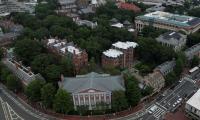Side-effect
The writer is a poet and author based in Islamabad.
In the Europe of the 1990s, when walls, countries, armies, ideologies and peoples were coming apart, I had a chance to spend some time across the continent.
I remember a colleague from those days quoting someone’s witty comment on the disintegration of Czechoslovakia. He said that even in case of such smooth and peaceful disintegration of their country where the Czechs got the Czech Republic and the Slovaks got their Slovakia, the ‘o’ in the middle of the country was left alone by both. Those who belonged to that ‘o’ – let’s call them the ‘Os’ – had nowhere to go.
My friend Saleem Shah never forgets to question me when I refer to Pakistanis as a ‘nation’ in my writings in this space. He wants me to be cautious on whether the term is used in the stream of consciousness or if the usage is in fact a deliberate choice. This is not a new argument. But it remains a valid one as questions surrounding the rights of provinces, nations and nationalities, lop-sidedness of the federation of Pakistan and the just distribution of resources among the federating units, underdeveloped areas and ethnic groups remain relevant.
Another way of putting the point across is that there is a theoretical divide in Pakistan which persists between those who think that it is a nation-state and those who believe that it is actually a state-nation. For those who continue to subscribe to the idea that Indian Muslims were one nation vis-à-vis Hindus and others in British India, Pakistan was formed as a nation-state.
On the other hand, for those who see Pakistan as a product of the interplay of certain historic forces at that time and the creation of the state of Pakistan as a demarcation of territory where Muslims were in majority but belonged to different racial, national and ethnic stock, Pakistan is a state-nation. The state was created before the nation could have been naturally formed. The evolution of a people as one nation is a long process in history spread over centuries, they argue. Hence, resistance movements in Pakistan against the imposition of a unitary form of government or a strong centre instead of provincial and regional autonomy were based on primary ethnicities or ethno-lingual (if not racial) categories.
Let us examine and reflect on these two competing narratives defining Pakistani state and nation. If Pakistan is a nation-state created on the basis of Muslims living across British India being one nation, then if they were one nation in 1947 claiming a state for themselves, why are at least three different nations in 2016?
If we go by this argument, all Pakistani Muslims, Indian Muslims and Bangladeshi Muslims should be considered one nation. You may say that they live in three different states. But is that really the case? Even Quaid-e-Azam Mohammed Ali Jinnah, before leaving Delhi for Karachi in 1947, had categorically told members of the All India Muslim League and Muslims who had to live in India after the creation of Pakistan that they should be loyal to the state in which they live.
Pakistan was a new name, given to the state of Indian Muslims created in provinces of British India where they were in a majority. Many of these provinces, if not all, had names from before. But it is not about what you call the territory. It is about people who inhabit that land for centuries, if not millennia. They all had their distinct names, identities, languages and culture. They were politically amalgamated into one nation based on a common religion due to their shared grievances and threat perceptions coming to the fore in the 1940s. But if now there is a Pakistani nation which is different from Indian and Bangladeshi Muslims, then it is a different nation from the one for which Pakistan was created. Isn’t that so?
The dismemberment of Pakistan only 24 years after the creation of the state could not be avoided in the name of a shared faith due to economic disparity and political disenfranchisement perpetrated by the strong centre dominated by West Pakistan. The majority Bengali province of East Pakistan decided to change its primary identity from Muslim to Bangla.
After the creation of Bangladesh, West Pakistan became Pakistan simply by a decree. Even before East Pakistan had seceded, Balochistan had been restless and there was widespread disenchantment with the state in Sindh and the then North West Frontier Province (NWFP) due to the creation of One-Unit in West Pakistan with Lahore as its capital. Later too, we see rights movements in all smaller provinces of Pakistan and in southern Punjab. Even if they were and are not necessarily secessionist – although some are – they were all organised on the basis of ethnicities and ethno-linguistic groupings.
Now let us look at the major competing argument – which says that, since Pakistan is a state-nation, it is artificial. It also contends that because it is not a nation yet or can be in near future, the questions of how the state which is governing this non-nation should formulate itself and whether it should be secular and plural or theocratic and exclusive cannot be answered.
There is a problem with this theory and an even bigger problem with the comprehension of those who propound this theory and base their political analysis on Pakistan being an odd mix of different peoples brought together in the name of faith – faith that could not cement them together enough when it comes to their economic, social, political and cultural rights.
Interestingly, the politicos and ideologues who profess this view also believe that India shouldn’t have been partitioned in the first place. India is seen as a natural state by most of them. So the Ladakhis and Himachalis belong to the Indian nation which also includes people as massively diverse as Tamils and Keralites, Bengalis and Punjabis, Orias and Gujaratis, Assamese and Rajasthanis, and those who are descendants of Afghan tribes or are the progeny of Anglo-Indian marriages.
But in case of Pakistan, Punjabis and Pakhtuns, Sindhis and Baloch are different nations. Now that’s interesting. And, since they are different nations, the state in which they live is artificial. I find these arguments equally problematic and lopsided as the theory that they challenge.
If we take an example from Afghanistan, when Tajiks and Pakhtuns can both be Afghans, why can’t Pakhtuns and Punjabis both be Pakistanis? Because even after living together for hundreds of years as Afghans and sharing many things in common, Tajiks and Pakhtuns remain quite distinct in many ways as well and retain their ethnicities and languages. Besides, if India should not have been partitioned in 1947, as it caused enormous suffering and the weakening of South Asian peoples, why should there be further partitions in the Subcontinent – on whatever lines or pretexts?
I think it is time to take stock of history and establish the truth, be fair to others but also be fair to ourselves and then move forward. Religion may not have had bound us together as a nation but I would humbly say again and again that Pakistan today is as natural or artificial as any other state. It is a matter of more time spent with each other, evolution of common cultural interests, shared political aims within a larger world and an integrated market that increases people’s dependence on each other and creates new markers of shared identity.
All countries are projects. All boundaries are political. All borders are products of certain historical conditions. Only rivers, mountains, deserts, plains, jungles and oceans are natural. For people of different origins, it is about sharing a state and being equal citizens in that state rather than making an effort to create a nation. The state has to create that equal stake and for that it has to be inclusive, democratic, fair and non-discriminatory.
But Saleem Shah, there will always be ‘Os’ like you and I – the connectors and those who believe that humanity is the only true nation.
Email: harris.khalique@gmail.com
It is clear that radical policy shift is essential if Pakistan seeks to make meaningful difference in its future outlook
Turkiye has realised reform that has attracted over $100 billion of investments into its electricity markets
Bill emphasises transparency through legally binding online Mining Cadastre System
Women-led carbon projects could be the triple wins – for climate, communities and credit buyers
Challenge for writers, readers, and activists today is to break down barriers that divide literature from people it is...
US must ditch tariff fetish, rally its allies and sit down with China to salvage trade before floor caves in







